-
It’s hard to believe today marks thirty years since the release of Doom—that’s thirty years of custom maps, megawads, total conversions and houses. It also marks thirty years of Kitchen Ace, thirty years of I Sawed the Demons, and thirty years At Doom’s Gate. From that first day on December 10th, 1993 when gamers got their first taste of ‘Doom,’ music has been one of the essential pillars of the game’s cultural impact. Sometimes lifted near 1:1 from their source material, the hard-rocking, heavy metal soundtrack of Doom set it apart from every other game in existence; one of the rumors regarding the music was that John Romero simply dumped a pile of Pantera, Metallica, ACDC and Slayer albums onto Bobby Prince’s desk and told him “something like this.”
Doom’s music has been covered innumerable times in every genre imaginable; YouTube is rife with professional and amateur remakes and demakes—hell, At Doom’s Gate has been recorded on a series of floppy drives! The music of Doom is such an iconic part of the game that 3DO, in their infinite wisdom, included a free copy of Doom with their absolutely banger cover album. During the development of Doom 2016, id Software had a “Coming to Satan” moment where they asked themselves, “What IS Doom?” Mick Gordon helped answer that question with a pulse-pounding metal soundtrack that pays homage to the original Doom music while giving us some of gaming’s all-time greatest tracks. BFG Division and Rip & Tear feel as quintessential “Doom” as any of the original music.
Through three original games, two remakes and a sequel, there has been a growing and thriving community of amateur mod makers who have kept the spirit of the original game alive for now thirty years. We’ve acknowledged the works of map makers and illustrators for the better part of Doom’s history with 10 Years of Doom and the annual Cacowards, but it wasn’t until 2020 that we started honoring the incredible work of musicians who, like Bobby Prince before them, are one of the essential pillars of this community and add immeasurable value to every map, megawad and TC they help score.
We’ve combed through thirty years of Doom mods and selected twenty-eight of the most important, the most beautiful, the most memorable music ever created by musicians in this community. To help us honor these works, we’ve recruited a host of prominent musicians and community members to tell us how these songs inspired them, the legacy they left behind, and why the artists behind them were so important. So join us, won’t you, for Doot Eternal, a.k.a. Meow That's What I Call Doom Music!
-
TNT: Evilution - Various Artists (1996)
TNT absolutely warrants mentioning in any conversation about music written custom for Doom maps – it was the forerunning levelset to feature upfront a definitive cast of musicians in Tom Mustaine, Leo Sieben, Jonathan El-Bizri and Josh Martel. While by no means a complete rewriting of the formula established by Doom 1 and 2, it was still a notable change-up in what players should come to expect in the years of custom wads to come. Guitars left, right and center; sawtooth leads getting major workout; destructive drum lines making full, oft-humanly-impossible use of the kit; and chilly ambience where appropriate, to boot. These tracks significantly up the ante, with heavier-hitting overall mixes, and fewer cases of reliance on repeated motifs with small variations, à la Bobby Prince. Without drawn-out runtimes or serious exhaustion of ideas, each track feels gutsier and punchier (and indeed more gutpunchy), and serves to give each map an indelible character. The difference in "vibe" as a result is observable even in the first few levels: just compare between MAP02 and MAP03, for instance.
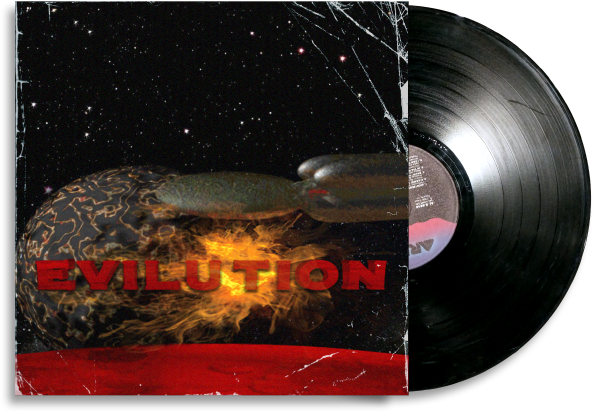
Many a nostalgia-goggled Evilution player may fondly remember how as soon as the big UAC door with its companion berserk pack melted into view, Sieben clubbed them round the ears with "Sadistic" right out of the gate. This was followed up shortly thereafter by "Smells Like Burning Corpse", cementing Sieben's tendency for hitting quite a bit harder than Bobby Prince ever did, with his brutal power chords and wailing guitar melodies in effectively brickwall-mixed* metal MIDIs – lest we forget "Into the Beast's Belly", which is the loudest Doom track known to man. Come MAP04, Sieben surprises us with his darker side, in the form of two skin-crawling offerings: "Death's Bells", a strident tubular-bell-centric piece effervescing with urgency; and "Agony Rhapsody", the soundtrack given to a cyberdemon's sleep-paralysis monster.
*It's true! The volume events in Sieben's MUS-converted tracks occasionally bug out in-game, because their values are set above 127! Sieben was writing unfeasibly loud music before Metallica made it uncool.
Tom Mustaine's offerings – "More", "Infinite", "Horizon", and "AimShootKill" – are more utilitarian, minimal, and focused on "riffs" instead of narrative ebb and flow. With much less comprehensive mixing (i.e. actual room for one's ears to breathe), Mustaine's pieces more closely resemble the work of Bobby Prince.
El-Bizri enters seven maps in, with the warped and unhinged sextuplet barrages of "Soldier of Chaos" and later on "Let's Kill at Will", both tunes laughing snidely in the face of conventional tonality but managing to somehow feel sufficiently weighty in their own right. El-Bizri's TNT output is, I think most can agree, the most widespread thematically, and – if honesty should prevail – the most scattershot consistency-wise. I dare you to compare: the haunting-but-groovy "Blood Jungle", with its tastefully urgent shifts between music-box psychological torment and rockin' guitar-laced panic; and the disaster-area dirge "Cold Subtleness", which pirouettes between cohesion and calamity with the grace of a stoner stumbling around and spouting singular pearls of shower-thought wisdom for every dozen or so intellectual misfires.
It'd be remiss of me not to mention the new incidental tunes, which include Tom Mustaine's iconic stuck-buzzsaw title track, and the emotionally devastating intermission powerhouse "Legion of the Lost" by Leo Sieben, which for many is perhaps the musical highlight of the entire mapset, lending palpable finality to each exit button press, and otherworldly weight to the secret level Pharaoh.
Josh Martel composed the five-second guitar/bass loop heard between episodes. It is unclear what he meant by this.
Whatever you make of the "infamous" TNT and its soundtrack – and you can make a lot with its multitude of ingredients – it's impossible to deny how many musical seeds it germinated in the Doom modding generations to come.
- @Jimmy
-
Icarus: Alien Vanguard - Various Authors (1996)
Icarus was the first TNT project to be released, albeit not the first to be created: that honor goes to TNT: Evilution, as its release was delayed in favor of inclusion into Final Doom. The two projects have some shared elements, and composers is definitely one of them: returning from Evilution are Tom Mustaine and Jonathan El-Bizri, alongside newcomers Jeremy Doyle and Charles Li, and Memento Mori II superstar David Shaw.
One strength Icarus shares with MM2 is that it has an entirely unique music composition for every level, allowing the WAD's soundscapes to reverberate far into each of the mod's spaceships, planet surfaces and simulation levels. David Shaw opens up "Recapture" with a groovy techno piece that perfectly gets you into the infiltration-and-termination mood every marine seeking to infiltrate a spaceship ought to possess, before the track slows down with a meditative piano that quickly builds up speed before sending off the track to its electronic roots and finishing off with a Bobby Prince rhythm from The Devil's Dead, showcasing Shaw's penchant for tributing other great musicians' works in some of his own compositions.
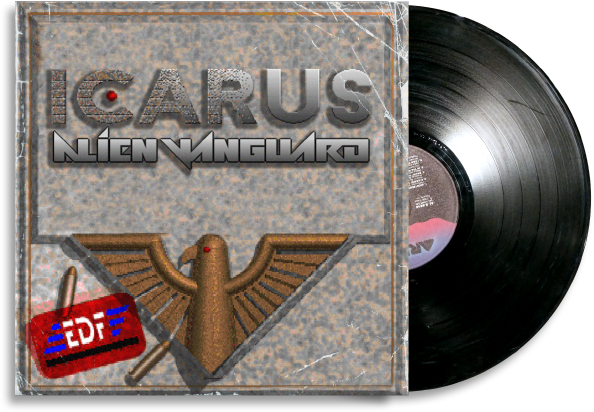
Tom Mustaine's three Slow Evil MIDIs give Icarus some of its atmospheric slow burns, but he is not afraid to reach for the stars with the finale, "Face of Evil". With its uplifting electric piano and breakneck pace, this track does an excellent job at making you feel like you're traveling inside computer wires. Fellow Evilution composer Jonathan El-Bizri once again covers a variety of genres, sometimes even within the same track, as evidenced by the Weapons Bay piece. Starting off as a slow and moody ambient track quickly accompanied by a mysterious, faint melody, only for El-Bizri to switch gears entirely in the second half as a high pitched, frantic guitar intrudes into the scene, provoking a sense of urgency that is carried through into the track's solo. Charles Li's two sole tracks also end up being an interesting amalgamation of groovy beats and interesting tonal shifts, and work quite well alongside the rest of the tracks.Last and definitely not least, Jeremy Doyle was able to first showcase his great talent in Icarus, providing some of the best and most varied tracks throughout the entire set. Whether it's the sinister tribal ambient of "Hell", the groovy basslines of "Melting" or the manic beats and pulsating synths of "Mad", his music is consistently reinvigorating and powerful. Doyle is especially successful at alternating quieter moments with intense riffage and sinister grandeur. And when he goes all in, he takes no prisoners, clearly seen with "Stomp", a powerhouse of a metal track that absolutely knocks the socks off most of its contemporaries, a non-stop action piece with frequent solos and enough aggression to blow away a demon horde all by itself.
All told, the music in Icarus deserves praise for straying even further than Evilution in its exploration of unique themes, and many of its tracks remain all-time classics that still regularly feature in other PWAD lineups.
- @Dynamo
-
Perdition's Gate - Tom Mustaine and Leo Sieben (1996)
Hot on the heels of the releases of Evilution and Icarus: Alien Vanguard, Tom Mustaine led a team working on a new megawad called Perdition's Gate, which was, at one point, even considered for inclusion as the third portion of Final Doom. When the window for that opportunity closed, it was instead given to WizardWorks and released commercially. With that company long being defunct and Tom Mustaine announcing in 2011 the rights had since reverted to the original creators, there has been a resurgence in interest in a classic 90s megawad that, for a long time, remained unknown to many owing to its limited availability.
Most of the music tracks are very much on the short side, with less than half of them reaching the two minute mark, a fitting characteristic considering Perdition's Gate's famously short and briskly paced maps. But what's most interesting about Perdition's Gate is that it can be seen as the b-sides of both Evilution and Icarus, not just because of the people behind it, but also because of the music itself. The shorter side pairs well with many of the tracks featured in the other two megawads, but most interestingly, leitmotifs and patterns that showed up in either are echoed in certain Perdition's Gate tracks. Tom Mustaine's "Pacemaker" begins with a guitar riff extremely similar to that of "FastTrack" from the latter portion of Icarus, and both tracks work very well as high-octane pieces even as they soon diversify, with Pacemaker maintaining a much more uplifting mood and ending with a rocking solo. Leo Sieben's Headshot Hole on the other hand reprises the famous bassline from Evilution's "Smells Like Burning Corpse" in a much heavier sounding package that breaks with the original completely halfway through.
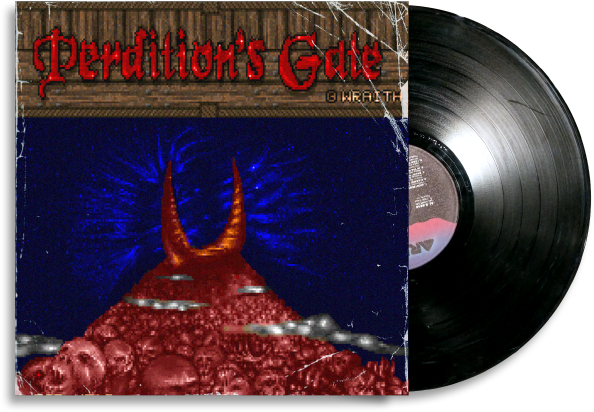
The Perdition's Gate tracks, while certainly not lacking in slower and atmospheric pieces, are best characterized by their breakneck pace and the sense of urgency they convey. Tom Mustaine expertly shifts between funkier tracks such as "ControlCV" and heavier, more intense pieces such as "Teeth" that nonetheless each achieve the same goal, helping to constantly push the player forward in a never ending cocktail of adrenaline, overrun techbases and ancient alien worlds. Leo Sieben is at the top of his game here, his tracks feeling particularly inspired as they evoke a great sense of gravitas concerning the events unfolding around you, as seen in "Maximum Horsepower", an impassionate track almost giving off a burning sensation to the listener, or for that matter the anxiety-driven arpeggios of "Flash Flood" and the amazing yet menacing sense of discovery one gets from listening to "Cruisin' with Devils".
Perdition's Gate's reputation has increased substantially in the community over the last decade, and as a result more of its music has steadily been used in projects of all kinds. And considering how good and versatile they are, I for one hope this trend will continue much further.
- @Dynamo
-
Memento Mori II - Mark Klem and David Shaw (1996)
Few soundtracks in Doom have ranked as highly as the one from Memento Mori II over the years. Fresh off having worked on the first MM1, which already had some seriously rocking tunes, Mark Klem produced some of the best Doom MIDIs of all time for this project, helped by the similarly great compositions of his fellow co-composer David Shaw.
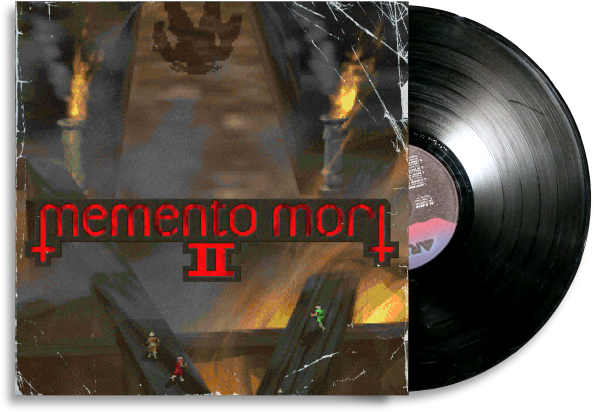
Nothing introduces Klem's ability as a musician better than "Give In (With Pleasure)". This tour-de-force of a MIDI starts off with an ominous but also somehow nostalgic bass, which soon gives way to a vibrant guitar melody that itself feels at once sinister and reassuring. Klem's chops are in full display throughout the song as the multiple guitars play intertwined melodies that complement eachother, and the sheer catchiness of the track only increases as the harmony changes midway through. The intense drumming never lets up as the track twists and turns in a vertigo of emotions, climaxing in the final solo which alternates between smooth melodies and whirlwind arpeggios, and feels straight out of a rock album. Other Klem highlights include "Midnight Call", starting off with curious pizzicato string arpeggios and dense foreboding percussion before the drums take over the center stage and eventually the bluesy final stretch accentuates the great sense of adventure in this music track, and also "Organic Gods", famously also used in Jade Earth, with its anxiety-inducing diminished triad arpeggios that breakdown into dense grooves, making for an ever shifting track where the tension never lets up.
David Shaw provides the other half of the soundtrack, and it's certainly no slouch either. "Fear's Falter" demonstrates the multitude of genres and styles present in the soundtrack, with an industrial-sounding section which then pivots to hard hitting metal interludes as the two styles then flow into each other at the end. "Anger's Reprise" starts off with a comforting marimba melody, until midway through the track changes tack to a remix of Mark Klem's "Hidden Anger" from MM1, providing a nice sense of continuation between the two megawads.
These are but a few of the gems that Memento Mori II holds, and with no repeating tune in its roster of 32 tracks, it's one album you gotta make sure to experience from beginning to end.
-
The Talosian Incident - John Bye (1997)
When it comes to Doom and ambient music, most people will immediately think of Aubrey Hodges' iconic soundscapes for the console versions of the game. While the original levels featured plenty of atmospheric tracks by Bobby Prince, in the '90s, the best known mod featuring an (almost) entirely ambient soundtrack is undoubtedly The Talosian Incident.
Created by a team led by John Bye (aka Gestalt666), who also composed almost the entirety of the mod's soundtrack (minus one piece by David Shaw), The Talosian Incident is the kind of mod that puts atmosphere at the forefront. The very first level sets the tone perfectly as a low, droning sound begins playing uninterrupted as the player explores the dark halls of the abandoned spaceship. This kind of track will be ubiquitous throughout the mod's duration, although short interludes such as the church organs in The Chapel or the muted guitar in The Great Outdoors occasionally break up the formula.
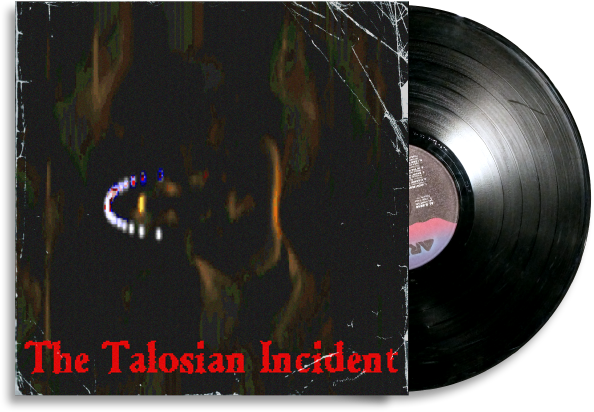
Most of the tracks in Talosian are quite long, some clocking at over 10 minutes, and occasionally some of them feature the same instrumentation but with a different progression - for instance, the two tracks that play in each Fort level, as the ones in Hardware and Get the Hell Out. Each track, however, succeeds at its primary goal of creating an intensely oppressive, unnerving ambiance. The Fort II's piece is emblematic of the Talosian style: it starts off with a continuous buzz that sounds like an air filtration system, before gradually introducing deep space-y synths, after which the track begins resembling the preceding one, with its high pitched and faint melodies accompanied by another droning background track, conveying a morose, almost mournful feeling as you take in the scenery, lost on a moonbase far, far away.
While many ambient pieces have since been produced in the Doom scene, The Talosian Incident's soundscape remains brilliant to this day, and conveys a feeling of loneliness and desolation that is nearly unmatched.
- @Dynamo
-
Requiem - Mark Klem, David Shaw and Jeremy Doyle (1997)
Following up Memento Mori II's soundtrack was a tall order, but Mark Klem and David Shaw are back, joined by Icarus ace Jeremy Doyle, for what was once considered to be the last great hurrah of Doom megawads. While it (thankfully) didn't pan out that way, Requiem nonetheless has left us with some veritable classics that remain instantly recognizeable to this day.
Mark Klem once again experiments with many different genres, and his tracks have a remarkably darker pitch to them than what he created for MM2 and STRAIN. The sinister tone of his tracks is most evident in "Breach of Madness", a disquieting piece where the high pitched piano deftly accompanies the groovy rhythm and the intermittent guitars, and which sounds no less chilling even when most of the instruments withdraw in favor of the throbbing bass. "Under Death" is another example of Klem's approach to atmosphere in Requiem, as the foreboding, incessant arpeggio weaves a tapestry of horrific visions for the perilous endeavors that lurk beyond, preparing the listener for the inevitable breakdown as more and more instruments are overlaid over the unsettling harmony.
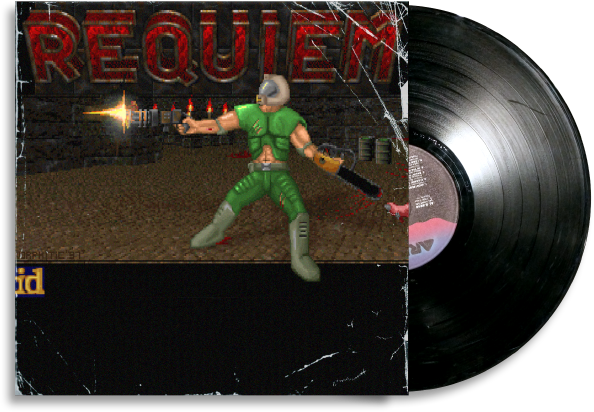
In contrast to Shaw's predisposition towards upbeat techno sounds in MM2 and Icarus, his Requiem contributions are much more tilted towards moodier, more deliberate tracks where percussions and bass predominate. "Breath of Sin" calls to mind the work of Lee Jackson and Bobby Prince on Duke Nukem 3D, with its wailing brass and laid back drumming. "The Helix" instead lulls in the listener with quiet, comforting bass lines and bright licks peppered throughout. For his part, Jeremy Doyle injects an enlivening dose of adrenaline into the soundtrack even with just three contributions. "Last Resort" reprises his metal chops with a steadily reinforcing prelude which gives way to thunderous guitars that catapult you head-first into the thick of the action. The more subdued "Skinny Puppy", on the other hand, still provides a feeling of haste with its peppy bass and oscillating synths, and is an excellent companion to the eponymous Czerwonka map.
Requiem was not the end of Doom modding, nor was it the end of the Doom composing career of any of the three composers involved, but it remains a landmark release and an endless source of inspiration for all the MIDI aficionados out there.
-
STRAIN - Mark Klem, David Shaw and Jon Landis (1997)
STRAIN's bizarre world of cybernetic creations and colorful stages definitely needed an appropriately zany and upbeat soundtrack to go with it. Thankfully, Mark Klem and David Shaw return once more, together with Jon Landis' only foray into megawad compositions. The resulting tunes are somewhat of a marked shift from the often Hellish, guitar-driven tracks of Memento Mori II and Requiem, opting for energetic, often stylish compositions that breathe life and soul into STRAIN's peculiar setting.
There's no better place to start for STRAIN's music than the very first offering, "TechnoDoom". This excellent track is a dense mosaic, choked full of musical threads and assorted timbres woven into a jaunty romp, one that never lets up in intensity even as it constantly shifts gears between blaring alarms, funky basslines, quivering synths and varied percussions. Klem isn't afraid to embrace unusual instrumentation even further in "Land of Able", which right off the bat evokes a sense of mystery with its shamisens and tribal drums, before leading into a full-fledged rock ballad of nostalgic flutes and soothing guitars, eliciting images of a place that feels alien yet, somehow, familiar. Don't get too comfortable however, for the track will soon pick up in speed and intensity, and hard hitting riffs eventually make way for one of Klem's spectacular finishing solos.
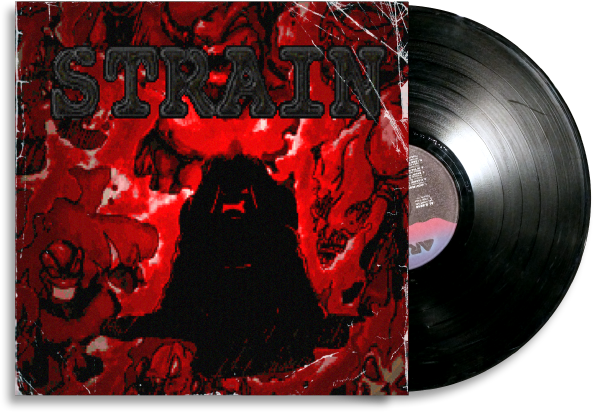
David Shaw gets comfortably back into his techno element in STRAIN, even though his compositions continue the slower, more atmospheric trend observed in Requiem. "Inner Turmoil" and "Scent of Hell" are veritable slow burns, echoing spent battlefields where only a few straggler demons remain wandering, dazed and confused. With "Suphilixious" and "Thin Ice", STRAIN's industrial, electronic themes take center stage and accompany the player through the corroded locales of a future gone awry. Shaw's last track, "Continue On", is especially interesting as its eerie opening gradually gives way to comforting rhythms, and even as the track starts gaining speed, it provides an uplifting sensation of homecoming. And just as well, as the track employs a leitmotif first seen in Jon Landis' Promenade composition. Landis' track is clearly inspired by Bobby Prince's Entryway, with its background organs playing ascending chromatic harmony, and it fittingly introduces STRAIN's short quasi-hub in its middle portion. The rest of Landis' tracks perfectly nail the vibe of the megawad as well, with enigmatic yet cheerful industrial machinations. Worth highlighting are Dispensary Beta's composition with its subtle, somewhat sinister atonal melodies, and of course, the grand finale's hyper-energetic music track that helps bring the experience to a satisfying, explosive conclusion.
STRAIN's music tracks definitely feel like they were made for its world, and yet they have successfully found their home in many other WADs, mega or small, in the years since. And given how good they are, I can frankly only hope that this trend continues.


